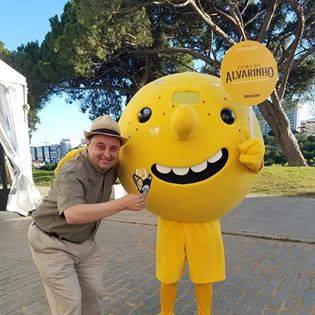Walking the hills of Lisbon will get you thirsty, and Paul and Tori have a few ideas about what you should drink when you’re in Lisbon.
Coffee, Juice and Soda
If you’re looking something to kickstart your day, you’re in luck. Coffee in Lisbon is so good and strong. You might want to ask for:
- Espresso: Café;. In Lisbon, it is also known as a bica
- Galão: Milk with espresso
- Americano: Big cup of coffee; espresso diluted with water
If you’re a fan of juice, get some freshly squeezed orange juice (sumo de laranja) at a cafe. Don’t be too alarmed by the bright orange color. It is incredibly good.
If you want something with a bit more of a sugar kick, get a Sumol. Sumol is a Portuguese soda that comes in different flavors. Paul and Tori highly recommend Sumol Ananas (pineapple Sumol).
Beer in Lisbon (Cerveja)
A cold beer is a perfect way to quench your thirst. And with numerous cafes and kiosques all around Lisbon, you can sit and take in this beautiful city while enjoying Paul and Tori’s favorite beer: Super Bock!
Super Bock is a Portuguese beer still owned by a Portuguese company. You’ll usually find the lager style on a menu, but they actually have a number of different styles which you can try at their stand in the Time Out Market.
Craft beer has a growing presence in Lisbon, but is still pretty small. There are some brewers popping up, and a great place to visit is Dois Corvos, a family-owned brewery in Lisbon.
Beer Sizes
There are several sizes to choose from when ordering a beer in Lisbon:
- Imperial – small, approximately a 7 oz beer
- Caneca – large, pint size
- Tulipa, also known as a medio – medium size beer
Portuguese Wine
Wine in Portugal is amazing in part because there are lots of indigenous grapes in Portugal, many which are unique to Portugal.
There are three types of wine that you will find on a menu:

- Vinho branco – white wine
- Vinho tinto – red wine
- Vinho verde:
- Young wine that can be white or red, though you’ll mostly find white on the menu
- Made in Minho region, which is in northern Portugal
- Features the alvarinho grape
If you are a fan of vinho verde and happen to be in Lisbon in early June, there is usually a vinho verde festival that takes place. If you’re lucky, you might even be able to take a photo with the Alvarinho grape!
Wine Regions in Portugal
There are many wine regions in Portugal, but there are three that you will often find on a menu.
- Alentejo
- Lovely region with miles of cork trees. Very stark, but very beautiful
- Really hot and dry area, which produces wines similar to California wines
- Reds – strong fruit flavors; full bodied
- Whites – soft but flavorful
- Dão
- Area north of Lisbon, in central Portugal
- Granite soil lends to a lighter, well-balanced style
- Douro Valley
- Rich wine region most famous for port wine
- Began producing robust table wines in the last 20-30 years
- Reds are similar to cabernets
- Whites are very crisp and minerally
Port Wine
Port wine is a fortified wine that is made when a neutral grape spirit is added to stop the fermentation process, boosting the alcohol content while retaining some of the natural sugar. Port is usually made with red grapes, though there is also white port.
History of Port Wine
Be sure to listen to Paul’s wonderful history lesson to get the full story on how port wine became a thriving industry in Portugal. The highlights:
- The Treaty of Perpetual Friendship between England and Portugal (1300s) allowed Portugal to be a source of wine to England, which was important because England and France were often at war and England needed its wine
- Wine would often go bad often during the the long journey
- Somewhere along the way, someone added a spirit to the wine to see if that would help to preserve it. It ended up creating port wine, which was a hit with the British
- The port wine trade boomed until people entered the market with inferior products (for example, using fruit other than grapes)
- The market began to collapse, and legit port producers asked the king to step in
- The king called in his right-hand man Sebastião José de Carvalho e Melo, better known as the Marquês de Pombal to come in and be his fixer
- The Marquês de Pombal (see more about him below) put policies in place that:
- Specified that only certain grapes, from certain spots in the Douro Valley, could be used to make port wine. This created one of the first demarcated areas for wine
- Established the Institute of Port Wine to oversee port quality and vintage declarations
Styles of Port Wine
There are several styles of port to choose from and you should try them all:
- White port: Made with white grapes. Perfect as a chilled aperitif or in a porto tonico. A great brand to try is Dalva
- Ruby: Made with red grapes. These are wines that have spent little time aging in wooden casks, and therefore are sweeter and a dark red color. There are several types of rubies:
- Basic ruby: Aged for the shortest amount of time
- Reserve: Higher end ruby; aged slightly longer
- Vintage: Most famous; made only in years with exceptional growing conditions. Aged two ears in a wooden cask and then bottled unfiltered so that the wine continues to get better
- Late Bottled Vintage: Wines aged for a few more years in a wooden cask and then bottled
- Tawny: Made with red grapes. They are aged in small wooden casks longer, and therefore are lighter in color. These tend to have a raisin/nut flavor. There are several types of tawnies:
- Basic tawny
- Aged tawnies: These have an age statement (ex. 10-year, 20-year tawny), which acknowledges the average age of the various blends of wine
- Colheita: These have a year statement. These are tawnies that use grapes all from the same year. They are very unique and have amazing character. Kopke has wonderful coheitas
To learn more about port wine, visit For the Love of Port.
Marquês de Pombal
The Marquês de Pombal was an incredibly forward-thinking and innovative man. After the Great Earthquake in 1755, which destroyed much of downtown Lisbon, the king asked the marquês to oversee the rebuilding of the city.
As part of his vision, he:
- Rebuilt the downtown on a grid system
- Ensured that earthquake-resistant buildings were established. These buildings have wooden infrastructure to provide additional support. You can see an example of Pombaline architecture at the Sporting Lisbon store in Lisbon
There is a huge statue on of the Marquês de Pombal at the top of the Avenida da Liberdade, looking down at downtown Lisbon (Baixa), which he reconstructed.

Recent Comments